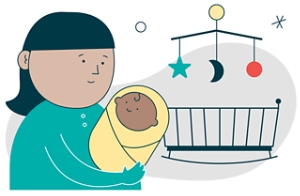Preeclampsia: Care Instructions
Preeclampsia is high blood pressure and signs of organ damage, usually after 20 weeks of pregnancy. If it's not managed, it can harm you or your baby and lead to dangerous seizures (eclampsia).

Most people with preeclampsia have healthy babies. Preeclampsia usually goes away in the weeks after birth.

In rare cases, symptoms of preeclampsia don't show up until days or weeks after childbirth.

Monitor yourself for symptoms of preeclampsia. Call your healthcare provider or midwife if you have symptoms such as a severe headache, vision changes, or sudden swelling in your face and hands.

Keep track of your blood pressure at home if your doctor or midwife asks you to. Ask your healthcare provider or midwife to make sure that the monitor is working and that you're using it right. Follow instructions about when to take your blood pressure and what to avoid before taking your blood pressure.

Take medicines exactly as prescribed. You may need to take medicine to control your blood pressure.

Do not use tobacco or tobacco-like products, including cannabis, and other substances. They can harm your health. They can also affect your baby’s growth, health, and the development of their brain and lungs. If you need help to use less or quit, talk to your healthcare provider, or go to the AlbertaQuits website.

Gain a healthy amount of weight. Talk with your healthcare provider or midwife about how much weight gain is healthy for you. Gaining too much weight while you're pregnant may be harmful.
Check your baby's movements. Once each day, time how long it takes to count 6 movements. If you don't feel at least 6 movements in 2 hours, call your healthcare provider or midwife. For more information on counting your baby’s movements, go to: Fetal Movement Count Chart (albertahealthservices.ca).
When should you call for help?

Share this information with your partner or a friend. They can help you watch for warning signs.
Call 911 anytime you think you may need emergency care. For example, call if:
- You passed out (lost consciousness).
- You have a seizure.
- You have trouble breathing.
- You have chest pain.
Seek urgent, immediate medical care at the hospital if:
- Your blood pressure is very high, such as 160/110 or higher.
- You have symptoms of preeclampsia, such as:
- Sudden swelling of your face, hands, or feet.
- New vision problems (such as light sensitivity, blurring, or seeing spots).
- A severe headache.
- New right upper belly pain.
- New severe nausea and vomiting.
- You are in your third trimester and do not feel your baby move at least 6 movements in 2 hours.
Call your healthcare provider, midwife, or nurse advice line (811) now or seek immediate medical care if:
- Your blood pressure is higher than your healthcare provider told you it should be, or it rises quickly.
- You have new nausea or vomiting.
- You think that you are in labour or are having contractions of your uterus with or without pain (6 or more in 1 hour).
- You have new belly pain.
- You have a sudden weight gain.
Watch closely for changes in your health, and be sure to contact your healthcare provider, midwife, or nurse advice line if you have any concerns.
Follow-up care is a key part of your treatment and safety. Be sure to make and go to all appointments, and call your healthcare provider or nurse advice line (811 in most provinces and territories) if you are having problems. It's also a good idea to know your test results and keep a list of the medicines you take.
Where can you learn more?
Go to https://www.healthwise.net/patientEd
Enter Z954 in the search box to learn more about "Preeclampsia: Care Instructions".
Adaptation Date: 11/27/2023
Adapted By: Alberta Health Services
Adaptation Reviewed By: Alberta Health Services
